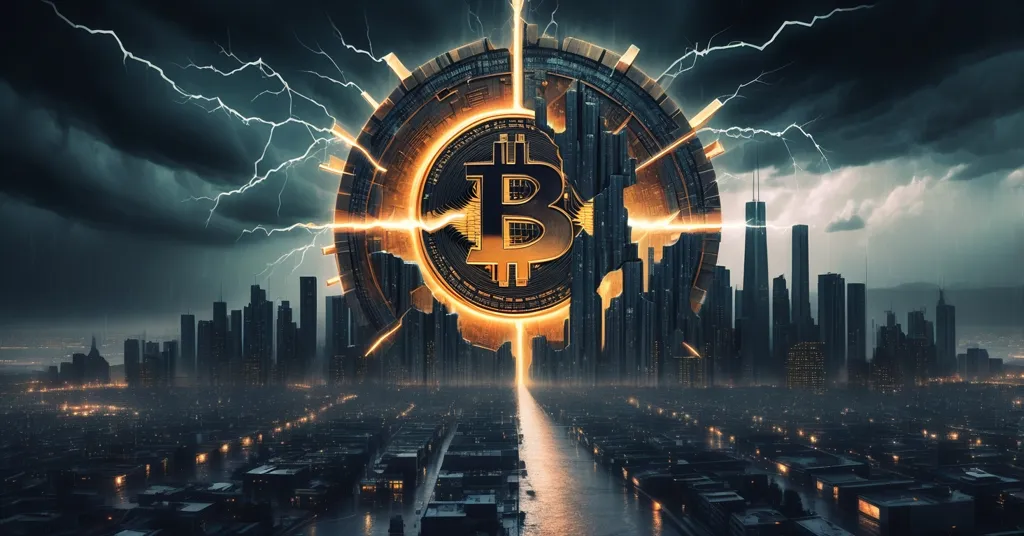Bitcoin Doomsday: Quantum Hacks and Nuclear EMP Threats to Crypto’s Future

Bitcoin’s Doomsday Scenarios: Quantum Hacks and Nuclear EMP Threats
Bitcoin, the bedrock of decentralized finance, has hit staggering heights with a recent peak near $112,000 per coin, anchoring a $2.227 trillion slice of the $3.91 trillion crypto market. But don’t pop the champagne just yet—lurking in the shadows are existential threats that could torch this digital gold. While quantum computing gets all the buzz as a future crypto-killer, a far more brutal and immediate danger looms: a Nuclear Electromagnetic Pulse (NEMP) that could zap Bitcoin’s entire infrastructure into oblivion. Let’s unpack these nightmares and separate hype from hard reality.
- Quantum Risk: A theoretical breach of Bitcoin’s encryption, but far from reality today.
- NEMP Disaster: A nuclear blast’s electromagnetic wave could annihilate Bitcoin’s physical network.
- Global Tensions: Rising nuclear conflict odds make EMP scenarios scarily plausible.
Quantum Computing: A Distant but Creeping Threat
Quantum computing has been hyped as the ultimate Bitcoin assassin. The concept is chilling—a quantum machine, leveraging mind-bending physics, could crack the cryptographic locks securing Bitcoin wallets. Specifically, it could use algorithms like Shor’s to derive private keys from public ones, exposing funds in older wallet setups like pay-to-public-key (p2pk) and reused pay-to-public-key-hash (p2pkh). These early address types, common in Bitcoin’s infancy, reveal critical data that modern formats hide, making them a weak link. Roughly 4.5 million Bitcoins—worth over $500 billion at today’s prices, including some of Satoshi Nakamoto’s legendary stash—are sitting in these vulnerable setups. That’s a massive target for a quantum thief.
Before you start sweating, let’s ground this in reality. Quantum tech isn’t there yet—nowhere close. Current systems, like Google’s Willow chip with 105 qubits (the quantum equivalent of bits, but capable of existing in multiple states at once), or IBM’s roadmap to 1,000 qubits by 2026, are laughably far from the millions of stable, error-corrected qubits needed to break Bitcoin’s Elliptic Curve Digital Signature Algorithm (ECDSA)—the math that ensures only you can spend your coins. Even if a quantum hacker somehow pulled it off, they’d need to crack a key and push a theft transaction within Bitcoin’s tight 10-minute block confirmation window. With error correction still a pipe dream for quantum engineers, that’s a tall order. The National Institute of Standards and Technology (NIST) pegs this threat as a 2030s problem at the earliest, and even BlackRock’s 2025 Bitcoin ETF filing lists it as a long-term worry, not today’s crisis. For deeper insights, check out this overview on post-quantum cryptography.
Still, the Bitcoin community isn’t sleeping on this. Developers are already exploring post-quantum cryptography (PQC) solutions, like lattice-based or hash-based schemes, to fortify the network. Proposals for soft forks to integrate quantum-resistant signatures, such as Schnorr-based models, are floating around forums like GitHub and Bitcoin Talk. Initiatives like Project Eleven’s Q-Day Prize incentivize research into this looming “quantum doomsday.” For users, simple steps like avoiding address reuse and adopting modern formats like Taproot can minimize exposure. Bitcoin’s decentralized ethos shines here—its $2 trillion “honey pot” drives innovation that could set the standard for securing all digital systems, from banking to communications, against quantum breaches. A 2023 EY report estimates a 50-70% chance of cryptographic failures across industries within 5-30 years, so Bitcoin’s fight is everyone’s fight. For academic perspectives, explore research on Bitcoin’s cryptographic defenses.
Nuclear EMP: The Immediate Apocalypse Switch
Now, forget code-breaking fantasies and picture a threat that doesn’t need a PhD to unleash hell: a Nuclear Electromagnetic Pulse, or NEMP. Imagine a nuclear warhead exploding 30 to 400 kilometers above Earth, releasing gamma rays that smash into the atmosphere, generating a monstrous electromagnetic wave. This invisible pulse surges over thousands of kilometers, frying every unprotected electronic device in its path like a lightning strike on steroids. Smartphones, power grids, and—crucially for Bitcoin—mining farms, nodes, and servers would be reduced to pricey junk. Bitcoin isn’t just elegant code; it’s a sprawling web of hardware and internet connectivity. An NEMP doesn’t give a damn about your air-gapped cold wallet if the entire ecosystem—exchanges, ISPs, data centers—is toast. Learn more about this risk in this detailed video on EMP impacts.
History offers grim proof. The 1962 Starfish Prime test, a US high-altitude nuclear detonation, knocked out streetlights and electronics in Hawaii, hundreds of miles away. Scale that to modern warfare, and you’re looking at a societal hard reset. As Albert Einstein warned in 1949:
“I know not with what weapons World War III will be fought, but World War IV will be fought with sticks and stones.”
His foresight cuts deep when you realize Bitcoin’s survival hinges on a tech-driven world that could vanish in a flash. Without miners to validate transactions or nodes to sync the blockchain, the network stalls. Sure, some doomsday preppers might stash EMP-shielded gear in Faraday cages—metal enclosures that block electromagnetic waves—but Bitcoin thrives on mass participation, not a few bunker-dwelling hodlers. Over 90% of Bitcoin nodes rely on standard ISP infrastructure, per 2023 Bitnodes data, making the network as fragile as the grid powering your rig. Community discussions on platforms like Reddit highlight these EMP vulnerabilities.
Geopolitical Powder Keg: Timing Couldn’t Be Worse
What makes NEMP more than dystopian fan fiction? The world is a tinderbox. A YouGov poll reveals 68-76% of Europeans and Americans fear nuclear weapons will be used in a potential World War III. Nuclear-armed giants—Russia, China, North Korea, Iran, and the US—are rattling sabers, while flashpoints like the Israel-Iran conflict, marked by airstrikes and cyber skirmishes from state-linked groups like APT34 and CyberAv3ngers, push escalation closer to reality. A report highlights how hybrid warfare—blending cyberattacks on critical infrastructure with kinetic strikes—is already underway in regions of intense geopolitical tension. An NEMP isn’t a wild “what if”; it’s a logical extension of a planet teetering on the brink. For Bitcoin, ranked among the top 10 global assets by market cap per Infinite Market Cap, this vulnerability is a brutal irony—a decentralized dream tethered to a very centralized, fragile reality.
Bitcoin’s Resilience: Can We Outlast the Apocalypse?
So, can Bitcoin weather these storms? Let’s play devil’s advocate. On one hand, its decentralized design is a superpower—no single point of failure means a surviving copy of the blockchain could, in theory, reboot the network post-catastrophe. If a handful of nodes endure an EMP, Bitcoin lives. On the other hand, if 90% of nodes and miners go dark, is it really functional? Transactions would crawl, trust could erode, and your digital gold might as well be Monopoly money until infrastructure rebuilds. Bitcoin maximalists like myself champion its battle-tested grit over flaky altcoins, but let’s not drink the Kool-Aid—real-world fragility isn’t a bug to fork away. Some have called this kind of scenario a worst-case technological disaster for Bitcoin.
Against quantum threats, solutions are tangible. Beyond developer-led upgrades, users can protect themselves now with multisig wallets, cold storage, and modern address types. Ethereum and privacy coins like Monero are also tinkering with quantum-resistant tech, showing the broader crypto space isn’t idle, even if Bitcoin’s sheer size makes it the prime mover. But NEMP? That’s a beast. Individual EMP-proofing with Faraday cages or off-grid setups helps, and satellite-based solutions like Blockstream Satellite could keep nodes connected sans traditional internet. Yet, network-wide survival demands collective action—hardening global infrastructure or pushing for decentralized, low-tech mesh networks. Cold War-era US reports from 2017 flagged EMP as a grid-level threat; Bitcoiners should be screaming for similar urgency today. Curious about community thoughts? Check out this Q&A on Bitcoin and EMP security risks.
Here’s the rub: Bitcoin’s revolution isn’t just tech—it’s a middle finger to centralized control, a push for freedom and privacy through effective accelerationism. We’re all in on disrupting the status quo. But ignoring these doomsday risks, whether a distant quantum hack or a horrifyingly plausible nuclear strike, isn’t bold—it’s boneheaded. Picture waking up to a gridless world, your Bitcoin wallet safe but the network gone. Could your stack survive if the internet died tomorrow? We need to build a fortress, not a house of cards.
Key Takeaways and Critical Questions
- What are the biggest technological threats to Bitcoin’s survival?
Bitcoin faces quantum computing, which could eventually crack its encryption, and Nuclear Electromagnetic Pulse (NEMP), a nuclear blast effect that could obliterate its physical infrastructure in a heartbeat. - How imminent is the quantum computing risk to Bitcoin security?
It’s not urgent—NIST projects threats in the 2030s at the earliest, but Bitcoin developers are proactively working on quantum-resistant upgrades to stay ahead of the curve. - What is a Nuclear EMP, and why should Bitcoin users worry?
An NEMP is a devastating electromagnetic wave from a high-altitude nuclear explosion that destroys electronics across huge areas, threatening Bitcoin by wiping out critical mining rigs, nodes, and internet systems. - How do global conflicts heighten Bitcoin’s EMP vulnerability?
Rising tensions among nuclear powers like Russia, China, and the US, plus flashpoints like Iran-Israel clashes, increase the risk of nuclear escalation, making an EMP attack a terrifyingly real possibility for Bitcoin’s network. - What can Bitcoin enthusiasts do to mitigate these risks?
For quantum threats, use secure address types like Taproot and avoid key reuse; for EMP, consider shielded hardware, but know that the network’s survival depends on broader infrastructure resilience. - Does Bitcoin’s decentralization offer protection against catastrophic threats?
Partially—its lack of a central failure point gives hope for recovery, but mass node outages post-EMP could cripple functionality, showing that decentralization alone isn’t enough without community preparedness.



